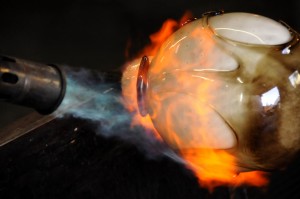
Hand-blown glass was invented in the middle of the last century B.C.E. Craftsmen discovered a technique called inflation, which involves inflating a ball of molten glass at one end of a blowpipe by blowing air into the opposite end of the blowpipe. When the glass is heated up to high enough temperatures to result in a molten state, it takes on liquid properties. At this point, a glassblower or gaffer will puff small bursts of air into the blowpipe, which directs the air into the center of the molten glass and begins to inflate it. As the glass cools, it begins to harden. This hardening is essential to forming the desired shape of the glass vessel that is being created. A process of heating, cooling and reheating is used to create the final product
The glassblower preheats one end of the blowpipe before dipping it into the molten glass in a furnace. After the desired amount of glass is clinging to the blowpipe, the glassblower will roll the blob of glass onto a slab of marble or a flat sheet of steel that are both cooler in temperature than the molten glass. By introducing the molten glass to this cooler surface, a hard skin is created on the outer layer of the glass. This assists in shaping the glass. After this step, the glassblower blows into the opposite end of the blow tube, inserting a bubble of air into the molten glass. At this point, various tools are used to shape the glass, including wooden paddles, large tweezers-shaped tools called jacks, and shears. The paddles flatten and cool the glass. The jacks are used to pull and twist the glass, and the shears are used to cut the glass. After the final size of the piece is achieved, the glassblower will finish the bottom of the piece first, which is attached to a long tube known as a punty. Once on the punty, the glassblower can shape the top of the piece and add colors and patterns to it.
Glass is heated to molten temperatures and shaped using three different furnaces. The first furnace contains the molten glass in its unformed state. The second furnace is called the glory hole. This furnace is used to reheat the glass as it cools in order to allow the glassblower to continue shaping the molten glass. The last furnace is used to cool the glass, slowly hardening it into its final state. This furnace is referred to as the annealer. Glass needs to cool slowly in order to prevent it from shattering. This furnace ensures that this happens by gradually lowering the temperature of the glass until it is completely cooled off.
How Is Hand-Blown Glass Made? | eHow.com











